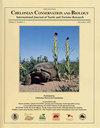得克萨斯钻石背土鳖(Malalemys terrpin littoralis)的猎物可得性和饮食分析
IF 0.8
4区 生物学
Q3 ZOOLOGY
引用次数: 4
摘要
钻石背龟(Malaclemys terrapin)是北美唯一一种专门生活在咸水和盐沼环境中的龟类。德克萨斯州亚种(Malaclemys terrapin littoralis)在德克萨斯州墨西哥湾沿岸的大部分地区被发现。先前对大西洋和佛罗里达亚种的猎物和饮食的研究发现,水龟的饮食主要由甲壳类和软体动物组成,尽管两性之间的饮食组成存在差异。此外,猎物可得性对沼泽中水龟的分布影响不大。我们研究了德克萨斯菱背龟的猎物可得性和饮食。随机捕获地点与水龟捕获地点的比较表明,猎物可得性不是影响德克萨斯州沼泽水龟分布的限制因素,但在捕获地点发现了多种显著的季节和地点差异。粪便分析采用多种指标,表明腹足类和十足类是德克萨斯龟的主要饮食成分。双瓣角螺和招潮蟹是所有龟类的重要猎物。雌雄龟的食性、季节食性以及不同湿地捕获的龟的食性均存在显著差异。我们的猎物可用性发现支持之前的研究,但粪便分析的结果表明,乌龟的饮食与之前报道的其他研究略有不同。综合研究结果扩展了对水龟食性的基本认识和理解,为今后水龟,特别是德克萨斯州水龟亚种的保护和管理提供了有益的依据。本文章由计算机程序翻译,如有差异,请以英文原文为准。
Prey Availability and Diet Analysis of Texas Diamond-Backed Terrapin (Malaclemys terrapin littoralis)
Abstract The diamond-backed terrapin (Malaclemys terrapin) is the only North American turtle species specialized for living in brackish and saltmarsh environments. The Texas subspecies (Malaclemys terrapin littoralis) is found along most of the Texas Gulf Coast. Previous studies on the prey and diets of Atlantic and Florida subspecies found that the diet of terrapins primarily consisted of crustacean and molluscan species, although differences in dietary composition were observed between the sexes. Furthermore, prey availability had little effect on terrapin distribution within a marsh. We examined the prey availability and diet of Texas diamond-backed terrapins. Comparisons of random locations to terrapin capture locations indicated that prey availability is not a limiting factor affecting terrapin distribution in Texas marshes, but multiple significant seasonal and locational differences in prey were detected at capture sites. Fecal analysis, using multiple metrics, indicated Gastropoda and Decapoda as major components of the diets of Texas terrapins. Plicate horn snails (Cerithidea pliculosa) and fiddler crabs (Uca spp.) were important prey items for all terrapins. There were significant differences between the diets of male and female terrapins, among seasonal diets, and among diets of terrapins captured at different marsh sites. Our prey availability findings support previous studies, but results from fecal analysis indicate a slightly different diet for terrapins than previously reported in other studies. The combined results extend the basic knowledge and understanding of terrapin diets, which will be useful for ongoing conservation and management of M. terrapin, especially the Texas subspecies.
求助全文
通过发布文献求助,成功后即可免费获取论文全文。
去求助
来源期刊
CiteScore
1.70
自引率
14.30%
发文量
17
审稿时长
>12 weeks
期刊介绍:
Chelonian Conservation and Biology is a biannual peer-reviewed journal of cosmopolitan and broad-based coverage of all aspects of conservation and biology of all chelonians, including freshwater turtles, marine turtles, and tortoises. Manuscripts may cover any aspects of turtle and tortoise research, with a preference for conservation or biology. Manuscripts dealing with conservation biology, systematic relationships, chelonian diversity, geographic distribution, natural history, ecology, reproduction, morphology and natural variation, population status, husbandry, community conservation initiatives, and human exploitation or conservation management issues are of special interest.

 求助内容:
求助内容: 应助结果提醒方式:
应助结果提醒方式:


